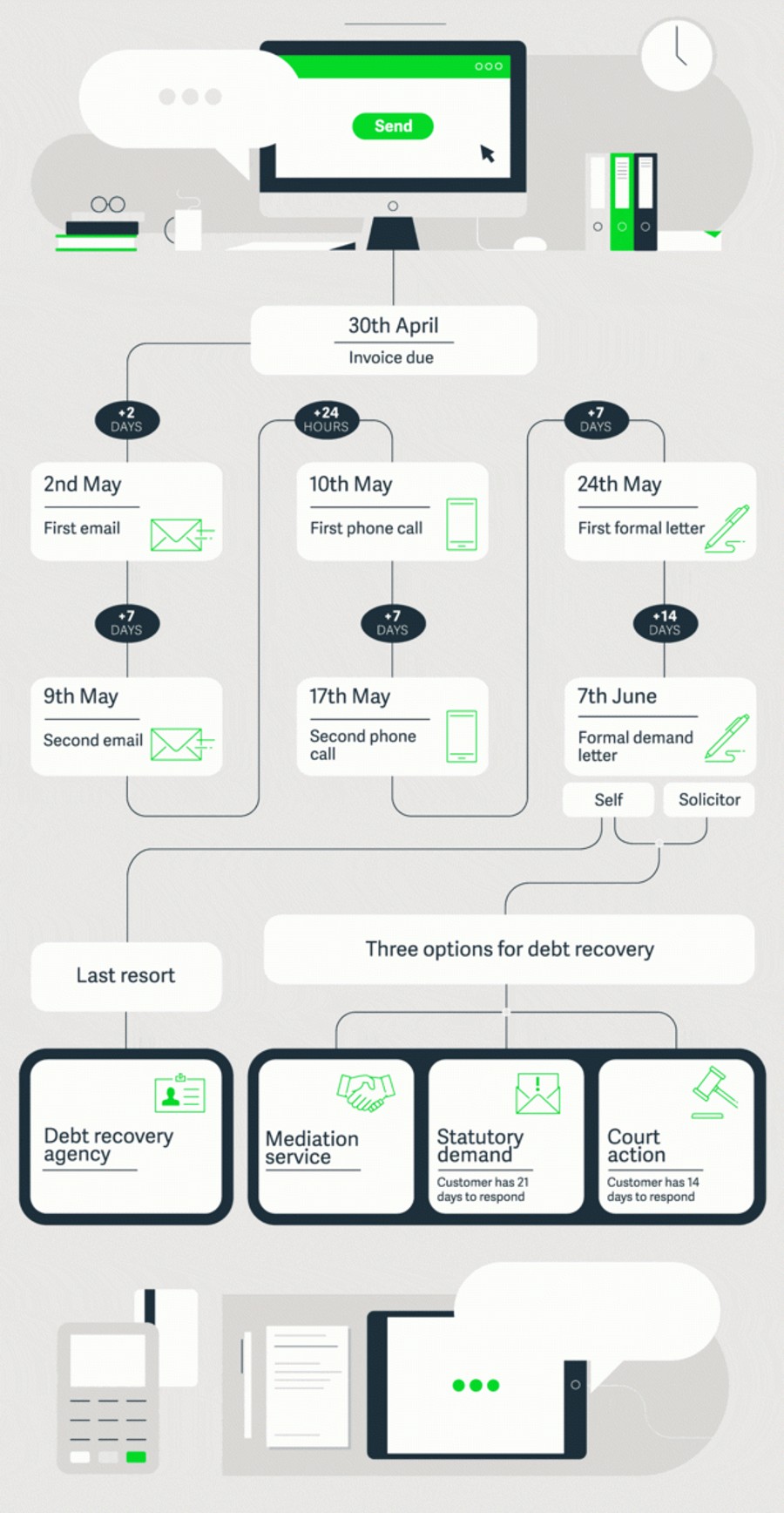All businesses rely on a balance of incoming and outgoing payments for cash flow. So when payments are late, a business with a modest turnaround can quickly go from a healthy balance to a strained financial situation. It makes sense then that SMEs are particularly vulnerable to cash-flow issues caused by late payments. Yet, research from Sage reveals that more than 1 in 10 SME invoices globally are paid late — or eventually written off as bad debt.
There may not be a way for you to guarantee that all your customers pay you in line with your agreed terms, but there are some things you could do to help facilitate timely payments, as Stacey McIntosh from Sage explores:
Reducing late payments
Arguably the most effective way to reduce the amount of time you spend on chasing outstanding invoices is to make it as easy as possible for your client to pay up. This means issuing invoices that are well formatted and correct, clearly laying out all the details your customer needs. Check for typos and other mistakes that might come across unprofessional and make sure any legal requirements are met. Here is a checklist of the key things your invoice should cover:
- The word ‘invoice’ in the title
- A unique invoice number
- Your company name and address
- The company name and address of your customer
- Summary description of product or service delivered
- Date the product/service was applied
- Date of the invoice
- Cost of individual products/services delivered
- VAT (if you are VAT registered)
- Total amount due
- Payment due date and other payment terms
- Purchase order number (if relevant)
- How to pay and bank or other payment details
You could also consider investing in billing software that minimises errors and late payment by generating automated invoices that let your clients pay directly online.
First steps if a payment is late
If a client does fall behind with a payment, consider your approach. Take these three steps to start with:
Be reasonable: Consider your history and ongoing relationship with the customer. Have you worked with them for a while, and are they typically reliable? Before you start chasing invoices or get hot under the collar, find out the reason why they’ve failed to pay you on time.
Be accurate: Also always double-check your invoice to ensure that the account information, payment amount and customer’s details are in order. Incorrect information on an invoice can lead to disputes and further delays.
Be diligent: Make a note of what has been agreed and any correspondence with the client, then send them a copy and offer them a chance to give their version of events. If you do end up having to take them to court you may need to prove that you were fair in your dealings with them and exercised due diligence.
Chasing a late payment
If you’ve confirmed that there were no problems or misunderstandings in relation to your invoice details or payment terms, and you’ve still not been paid, it’s time to follow up with the client.
Remember that as a small business you have legal protection. Unless other payment terms have been agreed in advance, your client has to pay you no more than 30 days after you have delivered the product or service in question.
Step 1: A friendly email reminder
Two days after the payment was due, send the client a friendly reminder. Make sure that you are communicating with the right person and check that they received the original invoice, attaching a copy of it.
Step 2: A second email reminder
Seven days after the first reminder, email the client again asking if there is any reason the invoice hasn’t been paid.
Step 3: A friendly call to the client
If the invoice still hasn’t been paid 24 hours after your second email reminder, call the client. Ask them if they received your email reminders, as well as when you can expect the payment. Immediately after your phone conversation, summarise what was said and email the summary to your client.
Step 4: A second phone call
If you’ve not been paid or had an update seven days after your first call to the client, call them again. Ask them why the invoice still hasn’t been paid and when it will be. Try to remain calm and reasonable throughout. Again, send the client a call summary afterwards.
Step 5: A formal letter
If the invoice remains unpaid seven days after your second call, send your client a formal letter outlining any interest and late payment fees that will now be applied.
Step 6: Second formal letter or solicitor’s letter
Send a solicitor’s warning letter or a second formal letter from yourself 14 days after your formal letter is sent with a final request for payment. Inform the customer that unless they pay the invoice within seven days, you will be issuing a statutory demand or proceeding to Court.
Use a signed-for delivery service so you can prove that your client received the letter. It’s worth seeking legal advice on how to word and structure this letter.
Step 7: Debt recovery action
If at this point your client is still refusing or unable to pay the invoice, you may have to get a third party involved. There are three debt recovery options for individuals and small businesses:
- Mediation
- Statutory demand
- Court action
Mediation is typically the best first step to try and resolve a dispute, and it’s often significantly cheaper than taking legal action.
If you want to see a visual representation of this process, take a look at the infographic presented here:

If you'd like further information on how to tackle late payments, take a look at our guide to Invoice Finance for small businesses, which explores how businesses can free up cash flow by borrowing money against unpaid invoices.
About the Author
Stacey McIntosh is the editor of Sage Advice UK and Sage Advice Ireland. He has more than 15 years of editorial, PR and social media experience, and has worked across print and online for national newspapers, magazines, PR and marketing agencies.









These cookies are set by a range of social media services that we have added to the site to enable you to share our content with your friends and networks. They are capable of tracking your browser across other sites and building up a profile of your interests. This may impact the content and messages you see on other websites you visit.
If you do not allow these cookies you may not be able to use or see these sharing tools.